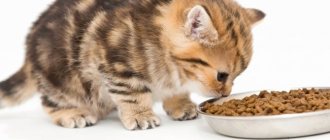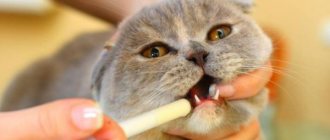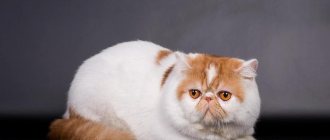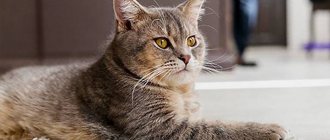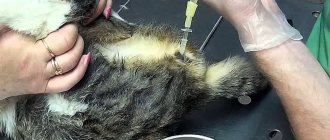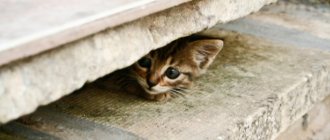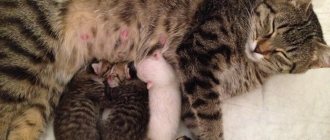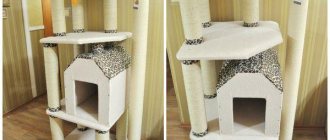Both animals and cattle drink,
And trees and flowers, -
Even flies are without water
Neither here nor here!
You can’t argue with the truth set out in the well-known water carrier song; the truth is here – in every word. Like the human body, the cat's body consists mainly of water - more than half. To stay healthy, your cat needs to get enough fluids, as proper hydration plays a vital role in all body systems, including the circulatory system, digestion and elimination. When the moisture content in the body drops by at least 5%, signs of dehydration begin to be observed. It can be very dangerous and even fatal for a pet if it is not noticed in a timely manner and emergency measures are not taken.
Cats living in the wild drink little: they get enough of the liquid contained in the meat of their prey. But a healthy domestic cat that eats dry food should drink about 60 ml of water per 1 kg of its body weight per day. This is especially true for neutered cats, who have a high risk of developing urolithiasis.
There are several reasons why a cat refuses to drink - we will talk about them later. First, let's figure out how to understand that a tailed animal lacks life-giving moisture.
The importance of water for an animal
The body of every creature consists of cells that are filled with liquid by 80%. They need their own set of microelements, which enter them only when dissolved in water. When a cat does not receive the required amount of water, this leads to negative changes in the body. Drying, hypotrophy, and in the most advanced cases, the death of living cells begins.
The required amount of water that a cat should drink daily is essential for the normal functioning of the circulatory system. Otherwise the blood becomes too thick. And in this form, it is more difficult for the heart to pump, which affects the delivery of oxygen to the muscles and various tissues. The heart and all vital organs of the animal suffer from a lack of water. Lack of oxygen also affects brain activity.
Clean water also has the ability to alleviate the condition of a sick animal. Suffering from an illness, a cat may not eat anything, but it should always drink water. Not every owner knows how to force a cat to drink water when the pet is sick and constantly sleeps. Sometimes the only option is to carefully inject water from a syringe. To do this, you need to sit the cat on your lap, remove the needle from a small syringe and gradually pour water into his mouth.
Cat in the wild
If all owners of domestic cats knew their history, they would not be surprised at their indifference to water. Most felines come from desert areas, where water is found in minimal quantities. Therefore, for the normal functioning of all internal systems, the cat’s body took moisture from food.
Only during times of severe drought or lack of food did predators have to go in search of a watering hole where they could replenish their liquid supplies. Some wild cats still consume minimal water. These breeds include sand and sand cats. It is almost impossible to see these animals drinking in the wild. The same goes for lions. They definitely drink water every day. But they are quite capable of living without it for up to 5 days. Even such a long period without water passes for them without harm to their health.
It is because of this that it should not be surprising that a pet does not drink water from a bowl well. This attitude towards liquid is inherent in their nature. However, this does not mean that you should limit their access to water and not control the daily amount your cat drinks. If he doesn’t drink enough, you need to figure out how to get the cat to drink more water and try to do everything so that your pet doesn’t feel the need for life-giving moisture.
Signs and stages of dehydration
Dehydration in animals is usually expressed as a percentage of the normal water content in the body.
If an animal loses only 10% of the total volume of moisture, if the deficiency is not replenished during the first day, the processes that begin in its body will be irreversible.
When a cat's body loses about 15% of its moisture, the animal dies.
The main signs of severe dehydration in an animal are:
- drying of the cat's nose (a leathery formation on the tip of his nose);
- dryness of the mucous membrane of the eyes and its hyperemia;
- cold extremities;
- blanching of the mucous membrane;
- changes in the quality of saliva, increasing its viscosity;
- apathy;
- deterioration in wool quality.
The animal squints at the light, refuses to play and, if it moves, it sways when moving, the fur does not lie in the direction of growth, it bristles, becomes dull - these are signs of serious exicosis, the cat needs immediate help.
In the process of dehydration of a pet’s body, several stages can be distinguished:
- Early (mild) - usually the owner does not notice it. Fluid loss is up to 5%, the animal may have a warm and hot tip of the nose (lobe or mirror), slight weakness.
- Medium - an attentive owner can notice its signs when examining the cat. Fluid loss ranges from 5 to 7%. Visible mucous membranes lose their elasticity and pink shine, become pale and dull. Saliva thickens, becomes viscous and sticky, which is easy to detect by touch. The rate of capillary refilling after compression is disrupted. This can be easily checked by pressing on your pet's gums. If the mucous membranes return to their color in 2-3 seconds, dehydration reaches 6%.
- Severe - the cat’s mucous membranes are poorly moisturized, saliva is viscous, little of it is produced, the nose is dry, the conjunctiva looks inflamed. When you press on the gums, the capillaries take about 6 seconds to recover. Dehydration reaches 8%. The animal is severely weakened. If rehydration does not begin and fluid loss reaches 10%, the capillaries cannot return to normal for up to 10 seconds, the animal’s body suffers irreversibly, and upon reaching 15-20% the cat dies.
Additionally, the owner can determine that a cat has problems with moisture entering the body using a skin test. You can take the skin on the withers with your fingers and pull it back. In severe exicosis, it retains such a prolonged abnormal position for a long time.
There are quite a few factors that can lead to this condition.
But the main causes of dehydration can be considered:
- lack of water intake in the cat’s body;
- its emergency removal (profuse or frequent/prolonged diarrhea, vomiting, massive blood loss).
An additional factor can be considered increased physical activity and overheating without the opportunity to drink enough.
Dehydration can occur as a result of serious infectious diseases for the cat (calcivirosis, leukemia, rhinotracheitis). Any illness that occurs with a high temperature causes exicosis.
Injuries that lead to external or internal bleeding cause loss of circulating fluid volume and hypovolemic shock. Internal bleeding is very dangerous because the owner cannot see it. Therefore, if after a fall from a height, the cat becomes weak, despite the fact that it drinks, it should be taken to the veterinarian.
Internal diseases (endocrine pathologies, kidney and digestive system diseases, pulmonary pathologies), toxic infections, helminthic infestations, poisoning, leading to diarrhea, diarrhea, or internal bleeding cause serious dehydration.
A cat that is left at home alone all day should be provided with plenty of water. If she doesn't get enough water, she may chronically suffer from mild dehydration that goes unnoticed by the owner. This is especially true for pets fed dry food. Such foods require increased drinking volume.
If the cat is playful and likes to run actively, or the room where it is kept is kept at a high temperature and the air is too dry, you need to provide it with free access to water and change the drink in its drinking bowl more often. The best solution would be to change the microclimate conditions, if possible.
If the animal shows signs of dehydration, it should be placed in a cool place and provided with drink. If the animal drinks on its own, this is a good sign, but perhaps the liquid drunk will not be enough. Because not only water is lost, but also salts. Their deficiency will have to be replenished intravenously or by injection into the withers area with glucose-salt rehydrants (solutions that restore the balance of electrolytes).
If your cat refuses to drink, you can try to encourage her to do so: wet her nose with water, add flavorings to her drink. If the pet refuses to drink, it should be given something to drink from a syringe and taken to a hospital.
Doctors are increasingly faced with the phenomenon of dehydration in cats. Since two-thirds of a cat’s body consists of water, its lack leads to irreversible consequences for the body. If the amount of fluid entering the body is 10% less than the required amount, it is possible to save the animal, but when this amount reaches 20%, dehydration leads to death. Why dehydration occurs and how to treat it is described in this article.
The cause of a lack of water can be pathologies occurring simultaneously in the body. Coping with the disease is possible only after successful procedures to restore water balance. Dehydration is usually caused by situations that accompany various diseases:
- change in temperature (during the occurrence of concomitant pathologies);
- vomiting, diarrhea (with gastrointestinal upset);
- excessive loss of fluid during urination and bowel movements (with kidney disease or diabetes);
- The lack of a container of water in a cat’s home becomes one of the main causes of dehydration in cats;
- staying outside for a long time in hot weather and getting heatstroke;
- inability to leave a closed, stuffy room for a long time;
- a situation in which the animal was severely injured and profuse hemorrhage occurred;
- feverish condition;
- being in a state of shock or stress during a long move, or acute pain during recent surgery.
Lack of water and urolithiasis
Insufficient water consumption contributes to the development of many diseases in your pet. First of all, the cat shows signs of urolithiasis. Lack of water provokes a high concentration of salt in the urine, which affects the appearance of urinary crystals. It is concentrated urine that becomes the culprit of this disease.
If a cat suffering from it drinks too little water, everything must be done to ensure that he drinks it in moderation. A veterinarian should tell you how to get a cat to drink water if it has urolithiasis when examining the animal. The disease develops quickly if it is not treated and the fluid consumed by the cat is ignored. Its course is complicated by the fact that symptoms appear already at an advanced stage. After diagnosis, treatment is very difficult and long. Castrated animals, as well as those feeding on dry food, are most susceptible to urolithiasis.
That is why every owner of a furry pet should know how to make a cat drink more water. Especially if he eats exclusively dry food.
Preventive measures
To prevent exicosis, you need to follow simple rules:
- keep a bowl of your favorite liquid within walking distance of the animal;
- if there is more than one cat living in the house, it is better to provide each of them with individual dishes;
- when treating any disease, monitor the cat, monitor its appetite and thirst;
- Along with dry food, give your cat wet food;
- monitor the time the animal spends in direct sunlight;
- If you are urinating frequently, have your pet examined by a doctor.
Some individuals prefer to drink running water. You can install a special drinking fountain for them.
To prevent a sensitive cat from touching the bowl with its whiskers, it should be low and spacious.
If you become dehydrated, it is important to take action quickly. When all fluid restoration procedures have been completed, the cat's chances of quickly curing the disease that led to dehydration increase.
If the cause of dehydration is a simple lack of fluid intake, the animal quickly recovers after receiving injections and replenishing moisture in the cells and connective tissues. The speed of recovery depends on the age of the cat, the presence of chronic diseases and the state of immunity.
Every owner needs to know how to treat dehydration in a cat, including at home. This will allow her to live without worries and please others for a long time.
Increased loss of water and beneficial microelements in the body is called dehydration. Unfortunately, this also often happens with our smaller brothers, in particular cats.
Water consumption rate
The amount of water required for the normal functioning of a furry pet is determined depending on the type of food it eats. When a cat eats natural food - porridge, meat, vegetables, its need for drinking water is much lower than for those animals that eat dry food. Plant foods contain enough moisture so that the cat does not feel very thirsty throughout the day. The same applies to liquid canned foods. Therefore, if the cat’s diet is completely natural or consists of canned food, there is no need to worry about a lack of water in the body.
To find out the required amount of water that a domestic cat should drink, you need to multiply the pet's weight by 0.03. Based on calculations, per kilogram of weight, you need 30 ml of clean water. This is exactly how you need to consider the norm when thinking about how to get a cat to drink water. Some owners pour too much of it into the bowl, and when the pet does not drink it in one day, they begin to panic and look for all sorts of ways to make him drink. In order not to worry too much about your beloved pet, you need to calculate its water intake and also take into account the food it consumes.
Where does a cat get liquid from?
Liquid is not just water. These are broths, gravies, porridge pates, milk, vegetables, meat, fish.
If you feed the animal with ready-made food, but not dry, but wet, then almost 80 percent of the necessary liquid comes from it. The body itself produces fluid from food. Each gram of protein provides 0.41 ml of liquid, each gram of fat - 1.07 ml, each gram of carbohydrate - 0.55 ml.
If an animal eats natural products, it needs to be given water based on the norm of 20 ml per 1 kg of body, this is the minimum amount of water to maintain vital processes.
With a dry diet, not only the weight of the animal is taken into account, but also the amount of food. Just multiply the number of pellets you eat by 2.
How to determine the lack of water in a cat
To determine how to get a cat to drink water, you need to make sure that he really lacks fluid. To do this, you can run several tests:
- First of all, you need to check the elasticity of the cat's skin. To do this, you need to grab a small area of skin between the shoulder blades and pull it slightly. After holding the skin for 5 seconds, you need to carefully release it. When dehydrated, the fold will take a very long time to return to its previous position. If the cat has enough water, the skin will sag instantly.
- It is necessary to look into the animal's mouth. His gums and mouth lining should be pink. There should be no yellowness, dryness or roughness. Pale and dry mucous membranes are the first sign of a dehydrated body.
- The pet's fur also reacts to a lack of water. It becomes dull and brittle. A healthy pet has smooth, shiny fur that does not fall out or get into shreds.
The main thing is to remember that before you force your cat to drink water, you should know for sure that he needs it.
If your cat drinks too much water
Sometimes, the cause for concern may not be that your pet is drinking too little water, but vice versa. A bad sign would be his suspiciously strong thirst. This can happen after prolonged exposure to the sun or excessive salt intake. Fortunately, such reasons are easily eliminated. You just need to pour more clean water into the cat’s bowl and wait until he drinks enough. If the thirst began without any reason, you need to be wary. An urgent need for large amounts of water can become a symptom of diseases such as diabetes, hyperthyroidism and many other pathologies. If your pet's thirst does not stop for several days, you should immediately contact a veterinary clinic.
How to measure the amount of liquid a cat drinks?
To do this, you will need a measuring cup or syringe so that you know exactly how much water you have poured into the bowl. At the end of the day, measure the remainder. Subtract the remaining volume from the poured volume. This way you will know how much water the cat managed to drink. The main thing is that during the measurements the cat does not have the opportunity to drink in another place. To obtain accurate data, the experiment is carried out over 3 days.
If you have several cats, you will have to keep them separately for these three days to find out exactly how much each one drinks.
How to raise a cat and make him drink more
If the animal does not drink enough, you need to think about how to get the cat to drink water. This is not an easy task, but a completely doable one. First of all, you need to get into the habit of changing the water in your cat’s bowl every day. These capricious creatures prefer to drink only fresh.
Another easy way to increase your cat's water intake is to place several bowls of water throughout the room. You can also install them at different levels so that he can choose the most comfortable position for himself. It is necessary to accustom the cat to bowls and wean him from drinking from other sources.
Do not forget that the cat may not like the container into which the owners pour water. The reason for this is an unpleasant odor or a container of the wrong size and depth. To determine your cat’s favorite bowl shape, you need to buy several options made of plastic and ceramic.
Prevention
Make sure the water in your cat's bowl is always fresh.
For preventive purposes, it is necessary to control your pet’s access to water.
Frequent outdoor exercise in summer should be provided with a small shelter for the animal. If a cat has chronic diseases or genetic pathologies, you should carefully monitor its condition, changes in mood, behavior, and changes in habits.
The diet must be balanced and contain sufficient fluid. The room where the pet is kept should not be stuffy.
- home
- >
- Cats
- >
- Cat health
- >
- How to detect dehydration in a cat? Symptoms of dehydration in a cat
Tricks to attract water
Those owners whose cats suffer from urolithiasis should be the most successful than others. Not everyone knows how to get a cat to drink water if they have urticaria. A small trick that can help with this is purchasing a special drinking fountain. Some cats really enjoy drinking running water that comes out of a faucet. A small drinking fountain will become your furry pet's favorite device.
You can use catnip to highlight your new water bowls. The animal will not remain indifferent to the tempting smell and will go to explore its territories. How to get your cat to drink water using catnip? You just need to blot a small cloth with liquid catnip and place a container of water on top. Such a bowl should be in every room where your pet has access.
What kind of water does a cat need?
Before getting a pet, you need to remember that you will have to feed and water it only with the highest quality products. This can be natural food or food from a good manufacturer. Regardless of the choice of food for a cat, every owner must provide the animal with clean and fresh drinking water. Veterinarians do not recommend giving your cat tap water. They claim that it will be healthier for the animal to drink spring or filtered water, since tap water contains a large amount of chlorine, metal salts and dirt. Boiled water does not have any beneficial substances.
If the cat only drinks water from the tap
This situation can be a problem for most owners. The question arises, how to teach a cat to drink water from a bowl, and why he prefers to ignore it. This behavior of a pet is due to the call of nature.
Since ancient times, cats have been looking for rivers and reservoirs with drinking, fresh water to quench their thirst. Their instincts told them that running water was much cleaner than that standing in puddles or swamps. Therefore, many cats are still confident that a babbling stream from a faucet is much healthier for them.
There is another interesting fact that is associated with the reluctance of cats to drink from bowls. In the wild, a cat has to eat its prey and leave its remains to rot on the ground. The water that is nearby becomes infected with corpse poisons released from carrion. That is why cats' instincts forced them to look for water away from food. First they ate the meat, and then went in search of a body of water, while ignoring those that were near the remains of the victim. This point should be taken into account when thinking about how to teach a cat to drink water from a bowl rather than from a tap. You just need to place a container of water a little further from the plate of food.
Veterinarian advice
Veterinarians advise carefully monitoring your domestic cat's daily drinking habits. This will allow you to notice a lack of water in the early symptoms of dehydration and even prevent the development of urolithiasis. Those who feed their pet dry food should be especially careful. It is worth remembering that such a diet increases the chances of developing urolithiasis. Veterinarians' advice on how to get a cat to drink water is quite simple:
- Change the water in the bowl up to 2 times a day.
- After each water change, the container must be thoroughly washed.
- Select several bowl options and give the animal a chance to choose the one he likes.
- Give your cat only spring or bottled water.
- Do not give boiled, tap or mineral water.
- Place the bowl away from the one from which the animal eats.
It is also necessary to remember that when eating dry food, the cat’s need for clean water doubles. Therefore, you should always monitor the amount you drink and monitor the cleanliness of the bowl.
Visual signs of dehydration in a cat
Dehydration in a cat
It is possible to determine the presence of dehydration by some visible signs.
The cat is lethargic, looks tired, moves its paws with difficulty. The gums feel dry and sticky to the touch, the eyes are sunken.
Cannot go to the litter box for a long time, has difficulty emptying, and is constipated. If you listen, you can hear a rapid heartbeat.
If a cat stays outside for a long time and lacks fresh water, it can suffer from heatstroke and dehydration.
The causes of dehydration can be quite varied.
- Diseases that are characterized by such manifestations as diarrhea and vomiting: diseases of the digestive system, intoxication, infection with worms.
- Pathologies in the animal’s body that cause frequent urination - endocrine disorders: diabetes mellitus, kidney failure.
- Staying outside for a long time in extreme heat or in a stuffy, enclosed room is a heat stroke .
- Inability to access fresh, clean water .
- Shock and stress conditions : recent operations, painful medical events, moving in a confined space.
- Pathologies or injuries accompanied by heavy blood loss.
- Feverish conditions .
- In addition, any painful condition manifested by an increase in body temperature - injuries, inflammatory processes - . The pet’s body is depressed in such cases and she refuses to take food and drink, which aggravates the course of the disease and general condition.
